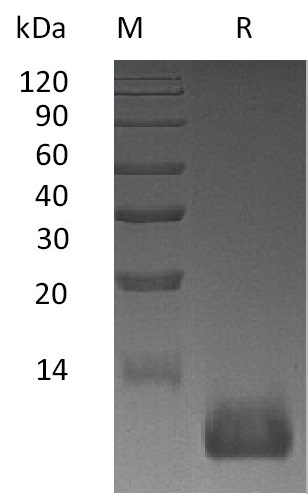- 全部删除
 您的购物车当前为空
您的购物车当前为空
SDF-1/CXCL12 Protein, Mouse, Recombinant
Mouse Cxcl12 is a secreted and highly conserved protein which belongs to the intercrine alpha (chemokine CxC) family.CXCL12 is widely expressed in various organs including brain, kidney, skeletal muscle, heart, liver, and lymphoid organs. Cxcl12 activates the C-X-C chemokine receptor CXCR4 to induce a rapid and transient rise in the level of intracellular calcium ions and chemotaxis. It also binds to atypical chemokine receptor ACKR3 which activates the beta-arrestin pathway and acts as a scavenger receptor for SDF-1. Cxcl12 has several critical functions during embryonic development such as B-cell lymphopoiesis, myelopoiesis in bone marrow and heart ventricular septum formation. Cxcl12 plays an important role in acting as a positive regulator of monocyte migration and a negative regulator of monocyte adhesion via the LYN kinase. It stimulates migration of monocytes and T-lymphocytes through its receptors, CXCR4 and ACKR3, and decreases monocyte adherence to surfaces coated with ICAM-1, a ligand for beta-2 integrins. SDF1A/CXCR4 signaling axis inhibits beta-2 integrin LFA-1 mediated adhesion of monocytes to ICAM-1 through LYN kinase. It also plays a protective role after myocardial infarction, induces down-regulation and internalization of ACKR3 expressed in various cells and stimulates the proliferation of bone marrow-derived b progenitor cells in the presence of IL-7 as well as growth of the stromal cell-dependent B-cell clone DW34 cells.

SDF-1/CXCL12 Protein, Mouse, Recombinant
| 规格 | 价格 | 库存 | 数量 |
|---|---|---|---|
| 10 μg | ¥ 820 | 5日内发货 | |
| 50 μg | ¥ 2,480 | 5日内发货 | |
| 500 μg | ¥ 12,100 | 5日内发货 | |
| 1 mg | ¥ 17,400 | 5日内发货 |
产品信息
| 生物活性 | Activity has not been tested. It is theoretically active, but we cannot guarantee it. If you require protein activity, we recommend choosing the eukaryotic expression version first. |
| 产品描述 | Mouse Cxcl12 is a secreted and highly conserved protein which belongs to the intercrine alpha (chemokine CxC) family.CXCL12 is widely expressed in various organs including brain, kidney, skeletal muscle, heart, liver, and lymphoid organs. Cxcl12 activates the C-X-C chemokine receptor CXCR4 to induce a rapid and transient rise in the level of intracellular calcium ions and chemotaxis. It also binds to atypical chemokine receptor ACKR3 which activates the beta-arrestin pathway and acts as a scavenger receptor for SDF-1. Cxcl12 has several critical functions during embryonic development such as B-cell lymphopoiesis, myelopoiesis in bone marrow and heart ventricular septum formation. Cxcl12 plays an important role in acting as a positive regulator of monocyte migration and a negative regulator of monocyte adhesion via the LYN kinase. It stimulates migration of monocytes and T-lymphocytes through its receptors, CXCR4 and ACKR3, and decreases monocyte adherence to surfaces coated with ICAM-1, a ligand for beta-2 integrins. SDF1A/CXCR4 signaling axis inhibits beta-2 integrin LFA-1 mediated adhesion of monocytes to ICAM-1 through LYN kinase. It also plays a protective role after myocardial infarction, induces down-regulation and internalization of ACKR3 expressed in various cells and stimulates the proliferation of bone marrow-derived b progenitor cells in the presence of IL-7 as well as growth of the stromal cell-dependent B-cell clone DW34 cells. |
| 种属 | Mouse |
| 表达系统 | E. coli |
| 标签 | Tag Free |
| 蛋白编号 | P40224 |
| 别名 | TPAR1,TLSF,Thymic lymphoma cell-stimulating factor,Stromal cell-derived factor 1,SDF-1,Sdf1,Pre-B cell growth-stimulating factor,PBSF,Cxcl12,C-X-C motif chemokine 12,12-O-tetradecanoylphorbol 13-acetate repressed protein 1 |
| 氨基酸序列 | Lys22-Lys89 |
| 蛋白构建 | Lys22-Lys89 |
| 蛋白纯度 | Greater than 95% as determined by reducing SDS-PAGE. (QC verified)  |
| 分子量 | 10 KDa (reducing condition) |
| 内毒素 | < 0.1 ng/µg (1 EU/µg) as determined by LAL test. |
| 缓冲液 | Lyophilized from a solution filtered through a 0.22 μm filter, containing 25 mM Tris-HCl, 150 mM NaCl, pH 8.5. |
| 复溶方法 | Reconstitute the lyophilized protein in distilled water. The product concentration should not be less than 100 μg/ml. Before opening, centrifuge the tube to collect powder at the bottom. After adding the reconstitution buffer, avoid vortexing or pipetting for mixing. |
| 存储 | Lyophilized powders can be stably stored for over 12 months, while liquid products can be stored for 6-12 months at -80°C. For reconstituted protein solutions, the solution can be stored at -20°C to -80°C for at least 3 months. Please avoid multiple freeze-thaw cycles and store products in aliquots. |
| 运输方式 | In general, Lyophilized powders are shipping with blue ice. Solutions are shipping with dry ice. |
| 研究背景 | Mouse Cxcl12 is a secreted and highly conserved protein which belongs to the intercrine alpha (chemokine CxC) family.CXCL12 is widely expressed in various organs including brain, kidney, skeletal muscle, heart, liver, and lymphoid organs. Cxcl12 activates the C-X-C chemokine receptor CXCR4 to induce a rapid and transient rise in the level of intracellular calcium ions and chemotaxis. It also binds to atypical chemokine receptor ACKR3 which activates the beta-arrestin pathway and acts as a scavenger receptor for SDF-1. Cxcl12 has several critical functions during embryonic development such as B-cell lymphopoiesis, myelopoiesis in bone marrow and heart ventricular septum formation. Cxcl12 plays an important role in acting as a positive regulator of monocyte migration and a negative regulator of monocyte adhesion via the LYN kinase. It stimulates migration of monocytes and T-lymphocytes through its receptors, CXCR4 and ACKR3, and decreases monocyte adherence to surfaces coated with ICAM-1, a ligand for beta-2 integrins. SDF1A/CXCR4 signaling axis inhibits beta-2 integrin LFA-1 mediated adhesion of monocytes to ICAM-1 through LYN kinase. It also plays a protective role after myocardial infarction, induces down-regulation and internalization of ACKR3 expressed in various cells and stimulates the proliferation of bone marrow-derived b progenitor cells in the presence of IL-7 as well as growth of the stromal cell-dependent B-cell clone DW34 cells. |




